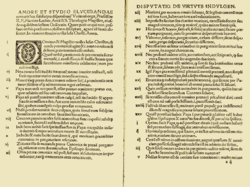
Back الإصلاح الإسكتلندي Arabic Reforma Escocesa AST Рэфармацыя ў Шатландыі Byelorussian Reforma escocesa Catalan Reforma escocesa Spanish اصلاحات پروتستانی اسکاتلند Persian Réforme écossaise French Reformasi Skotlandia ID Riforma scozzese Italian რეფორმაცია შოტლანდიაში Georgian

| Part of a series on the |
| Reformation |
|---|
 |
| Protestantism |
| History of Scotland |
|---|
 |
|
|
The Scottish Reformation was the process whereby Scotland broke away from the Catholic Church, and established the Protestant Church of Scotland.[a]. It forms part of the wider European 16th century Protestant Reformation.
From the first half of the 16th century, Scottish scholars and religious leaders were influenced by the teachings of the Protestant reformer, Martin Luther. In 1560, a group of Scottish nobles known as the Lords of the Congregation gained control of government. Under their guidance, the Scottish Reformation Parliament passed legislation that established a Protestant creed, and rejected Papal supremacy, although these were only formally ratified by James VI and I in 1567.
Directed by John Knox, the new Church of Scotland adopted a Presbyterian structure and largely Calvinist doctrine. The Reformation resulted in major changes in Scottish education, art and religious practice. The kirk itself became the subject of national pride, and many Scots saw their country as a new Israel.
Cite error: There are <ref group=lower-alpha> tags or {{efn}} templates on this page, but the references will not show without a {{reflist|group=lower-alpha}} template or {{notelist}} template (see the help page).
© MMXXIII Rich X Search. We shall prevail. All rights reserved. Rich X Search